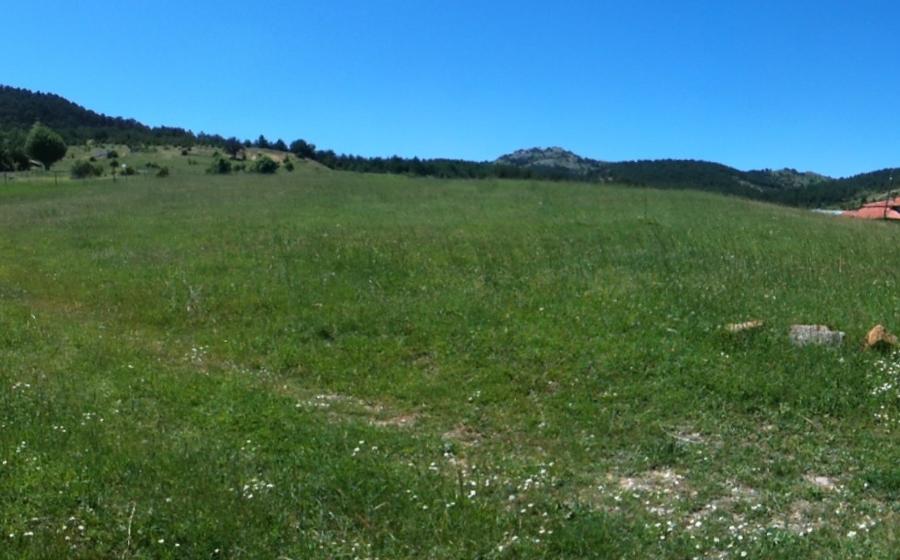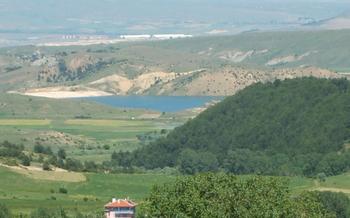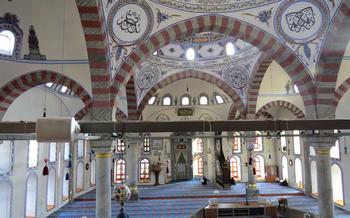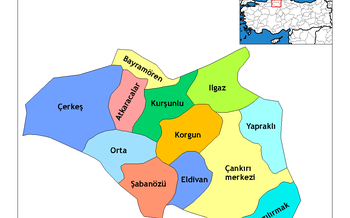
Yıldırım Beyazıt Mosque
- History of the Yıldırım Beyazıt Mosque
- Location
- Architecture
- Interior Design
- Historical Significance
- Religious Significance
- Prayer Hall
- Minaret
- Courtyard
- Visiting Hours
- Dress Code
- Photography
- Local Customs
- Nearby Attractions
- Insider Tip: Unveiling the Hidden Gem
History of the Yıldırım Beyazıt Mosque
The Yıldırım Beyazıt Mosque, also known as the Ulu Mosque, stands as a testament to the rich history and architectural heritage of Çankırı, Turkey. Built during the reign of the Ottoman Sultan Yıldırım Beyazıt, the mosque holds immense significance in the city's cultural fabric.
Its construction began in 1397 and was completed in 140The mosque's architecture showcases a harmonious blend of Seljuk and Ottoman architectural styles, reflecting the transition period in Turkish history. The mosque underwent several renovations and additions throughout the centuries, contributing to its distinct and multifaceted character.
One of the unique features of the Yıldırım Beyazıt Mosque is its prayer hall, which can accommodate up to 2,000 worshippers. The hall is adorned with intricate calligraphy, tilework, and stained glass windows, creating an awe-inspiring and spiritual ambiance. The mosque's minaret, towering over the cityscape, serves as a beacon of faith and a symbol of Islamic architecture.
Location
The Yıldırım Beyazıt Mosque stands tall in the heart of Çankırı, Turkey, a city steeped in history and natural beauty. It is conveniently situated in the central district, within easy reach of several prominent landmarks and attractions. The mosque's proximity to the Çankırı Castle, a magnificent fortress with panoramic city views, makes it an ideal starting point for exploring the city's rich heritage. Visitors can easily navigate to the mosque using various transportation options, including local buses, taxis, or by foot from nearby hotels or guesthouses. The central location of the Yıldırım Beyazıt Mosque ensures that it is accessible to both domestic and international tourists, offering a unique glimpse into the architectural and spiritual treasures of Çankırı.
Architecture
The Yıldırım Beyazıt Mosque exhibits a harmonious blend of Seljuk and Ottoman architectural styles, reflecting the rich cultural heritage of Çankırı. The mosque's overall design showcases a rectangular plan with a central dome supported by four massive pillars. The dome, a characteristic feature of Ottoman architecture, dominates the skyline and creates a sense of grandeur. The exterior walls are adorned with intricate carvings and decorative elements, showcasing the craftsmanship of the Seljuk era.
The mosque's interior is equally impressive, featuring a spacious prayer hall with a high ceiling and a captivating atmosphere. The mihrab, a niche indicating the direction of Mecca, is intricately carved with verses from the Quran and is a focal point of the prayer hall. The minbar, a raised platform used for delivering sermons, is also adorned with fine carvings and adds to the overall grandeur of the interior. The mosque's windows, adorned with colorful stained glass, allow natural light to filter in, creating a warm and inviting ambiance.
Interior Design
The interior of the Yıldırım Beyazıt Mosque is a testament to the exquisite craftsmanship and artistic expression of the Seljuk and Ottoman periods. The walls are adorned with intricate calligraphy, featuring verses from the Quran and poetic inscriptions praising the Prophet Muhammad and the Ottoman sultans. The mihrab, the niche indicating the direction of Mecca, is a masterpiece of artistry, crafted from finely carved marble and adorned with colorful tiles. The stained-glass windows, with their vibrant hues, cast a warm and ethereal glow throughout the prayer hall, creating a sense of tranquility and reverence. The overall ambiance of the mosque's interior is one of harmony and elegance, inviting worshippers to immerse themselves in spiritual contemplation and devotion.
Historical Significance
The Yıldırım Beyazıt Mosque holds significant historical importance as it is closely associated with the Ottoman Sultan Yıldırım Beyazıt, who reigned during the late 14th and early 15th centuries. The construction of the mosque is attributed to his reign, reflecting his commitment to religious and architectural patronage. Throughout history, the mosque has served as a religious and cultural center for the local community. It has witnessed significant events and transformations, becoming an integral part of the city's rich heritage. The mosque continues to attract visitors and pilgrims who seek to immerse themselves in its historical significance and experience the spiritual atmosphere that it exudes.
Religious Significance
The Yıldırım Beyazıt Mosque holds immense religious significance for the Muslim community in Çankırı and beyond. It serves as a central place of worship, where Muslims gather to perform their daily prayers, including the congregational Friday prayers. The mosque's spacious prayer hall can accommodate a large number of worshippers, fostering a sense of unity and community among them.
Throughout history, the mosque has played a crucial role in shaping the religious and cultural landscape of Çankırı. It has been a place where religious teachings are imparted, Islamic traditions are upheld, and spiritual guidance is sought. The mosque's association with the Ottoman Sultan Yıldırım Beyazıt further enhances its significance, as it represents the enduring legacy of the Ottoman Empire in the region.
During religious festivals and celebrations, such as Eid al-Fitr and Eid al-Adha, the mosque becomes a focal point for communal gatherings and festivities. Muslims from neighboring areas flock to the mosque to participate in special prayers, exchange greetings, and share the joy of these auspicious occasions. The mosque's vibrant atmosphere during these times reflects the deep connection between the local community and their faith.
Prayer Hall
At the heart of the Yıldırım Beyazıt Mosque lies its spacious prayer hall, inviting worshippers to immerse themselves in spiritual tranquility. The vast hall can accommodate a substantial number of devotees, allowing for communal prayers and religious gatherings. The interior is adorned with elegant chandeliers and intricate designs, casting a warm and serene glow upon the faithful.
The arrangement of the prayer space adheres to traditional Islamic principles. The mihrab, an ornate niche in the wall, indicates the qibla, the direction towards Mecca. The minbar, an elevated platform, serves as the designated spot for delivering sermons and religious teachings. The overall ambiance of the prayer hall exudes a sense of devotion and spirituality, encouraging worshippers to connect with the divine.
Minaret
The Yıldırım Beyazıt Mosque boasts a towering minaret that stands as a symbol of its architectural grandeur. The minaret, which is the tallest structure in the mosque complex, is adorned with intricate carvings and tilework that showcase the craftsmanship of the era. Its height allows the call to prayer to reverberate throughout the city, summoning the faithful to congregate for their daily prayers.
While the minaret is not accessible to visitors for safety reasons, its impressive exterior can be admired from various vantage points around the mosque. Its presence adds a majestic touch to the mosque's skyline, making it a prominent landmark in the cityscape of Çankırı.
Courtyard
The Yıldırım Beyazıt Mosque features a spacious and serene courtyard that adds to its overall aesthetic appeal and functionality. The courtyard serves as a gathering space for the community, providing a place for ablutions, relaxation, and socialization. Its architectural elements contribute to the mosque's overall design, creating a harmonious and inviting environment.
Visitors can find a central fountain in the courtyard, which provides a soothing ambiance and serves as a source of water for ablutions. The courtyard is surrounded by arched walkways and colonnades that offer shelter from the sun and rain, allowing visitors to comfortably navigate the space. Gardens with vibrant flowers and lush greenery adorn the courtyard, adding a touch of natural beauty and tranquility.
The courtyard also includes several seating areas, where visitors can rest and reflect before or after their prayers. It's a place where the community gathers for religious celebrations, social events, and community meetings, fostering a sense of togetherness and camaraderie among the mosque's congregation.
Visiting Hours
The Yıldırım Beyazıt Mosque is open to visitors daily, offering an opportunity to admire its architectural beauty and spiritual significance. The mosque's doors are typically open from sunrise to sunset, allowing visitors to explore the mosque's intricate interior and experience the serene atmosphere during different times of the day. However, it's important to note that specific prayer times may restrict access to certain areas of the mosque, such as the prayer hall. Respectful behavior and understanding of local customs are essential when visiting the mosque during prayer times.
To avoid any inconvenience, it's recommended to plan your visit outside of the main prayer times, which typically occur at dawn, midday, afternoon, sunset, and evening. By visiting during less crowded periods, you can fully immerse yourself in the mosque's tranquility and take your time exploring its architectural details without distractions. Whether you choose to visit in the soft light of dawn or the golden glow of sunset, the Yıldırım Beyazıt Mosque offers a unique and awe-inspiring experience for visitors seeking spiritual enlightenment and cultural appreciation.
Dress Code
When visiting the Yıldırım Beyazıt Mosque, appropriate dress is essential. As a place of worship, visitors should dress modestly and respectfully. For men, this means covering their legs and shoulders, while women should cover their hair, arms, and legs. It is also customary to remove shoes before entering the prayer hall. This is a sign of respect and cleanliness, as the prayer hall is considered a sacred space. Visitors should also be mindful of their behavior and etiquette while inside the mosque. This includes speaking quietly, avoiding distractions, and refraining from taking photographs without permission. By following these guidelines, visitors can show their respect for the religious significance of the mosque and contribute to a peaceful and serene environment for worship and reflection.
Photography
Photography enthusiasts are welcome to capture the beauty of the Yıldırım Beyazıt Mosque, but a few guidelines must be followed to ensure respect for the sacred space. Firstly, using flash photography or tripods is strictly prohibited within the mosque. These devices can be disruptive and disrespectful during prayer times or religious ceremonies.
Before taking any photographs, visitors are advised to seek permission from the mosque's officials or caretakers. This simple gesture shows respect for the sanctity of the mosque and helps avoid any misunderstandings or disruptions.
While capturing the architectural and decorative elements of the mosque is encouraged, it is essential to be mindful of the privacy of worshippers. Avoid taking photographs of individuals without their consent, especially during prayer or other religious activities.
By following these guidelines, visitors can respectfully document their visit to the Yıldırım Beyazıt Mosque while preserving the sanctity and serenity of this sacred space.
Local Customs
When visiting the Yıldırım Beyazıt Mosque, it is essential to be mindful of local customs and traditions to show respect for the religious significance of the mosque. Visitors should dress modestly, covering their shoulders and knees. Shoes must be removed before entering the prayer hall, and a designated area is usually provided for this purpose. While inside the mosque, it is considered disrespectful to talk loudly, laugh, or engage in any disruptive behavior. Visitors should also avoid pointing their feet towards the qibla, the direction of prayer. When interacting with locals, it is essential to be friendly and respectful, using polite language and avoiding topics that may be considered sensitive or offensive. By observing local customs and showing respect for the mosque's sacredness, visitors can contribute to a peaceful and harmonious environment for all.
Nearby Attractions
In the vicinity of the Yıldırım Beyazıt Mosque, history buffs will delight in exploring the Çankırı Castle, a majestic fortress that commands panoramic city views. Immerse yourself in the rich history of the region at the Çankırı Museum, showcasing artifacts and exhibits that narrate the city's past. For a tranquil retreat, seek solace in the serene ambiance of the Ilgaz Mountain National Park, renowned for its breathtaking landscapes and invigorating hiking trails. Art enthusiasts can feast their eyes on the exquisite collection of Anatolian kilims and carpets at the Çankırı Kilim Museum, a testament to the region's vibrant textile heritage. Complete your cultural immersion with a visit to the Çankırı Ethnography Museum, where traditional costumes, tools, and household items offer a glimpse into the daily lives of Çankırı's ancestors.
Insider Tip: Unveiling the Hidden Gem
Apart from its architectural grandeur, the Yıldırım Beyazıt Mosque holds a captivating secret—the Tomb of Yıldırım Beyazıt. Nestled within the mosque's courtyard lies the final resting place of the illustrious Ottoman Sultan. As you explore the mosque, take a moment to visit the tomb, where you can pay your respects to this revered figure and learn about his remarkable legacy. The tomb's serene atmosphere and intricate carvings offer a glimpse into the rich history of the Ottoman Empire. Embrace this unique opportunity to connect with the past and discover the hidden gem that makes the Yıldırım Beyazıt Mosque truly extraordinary.









